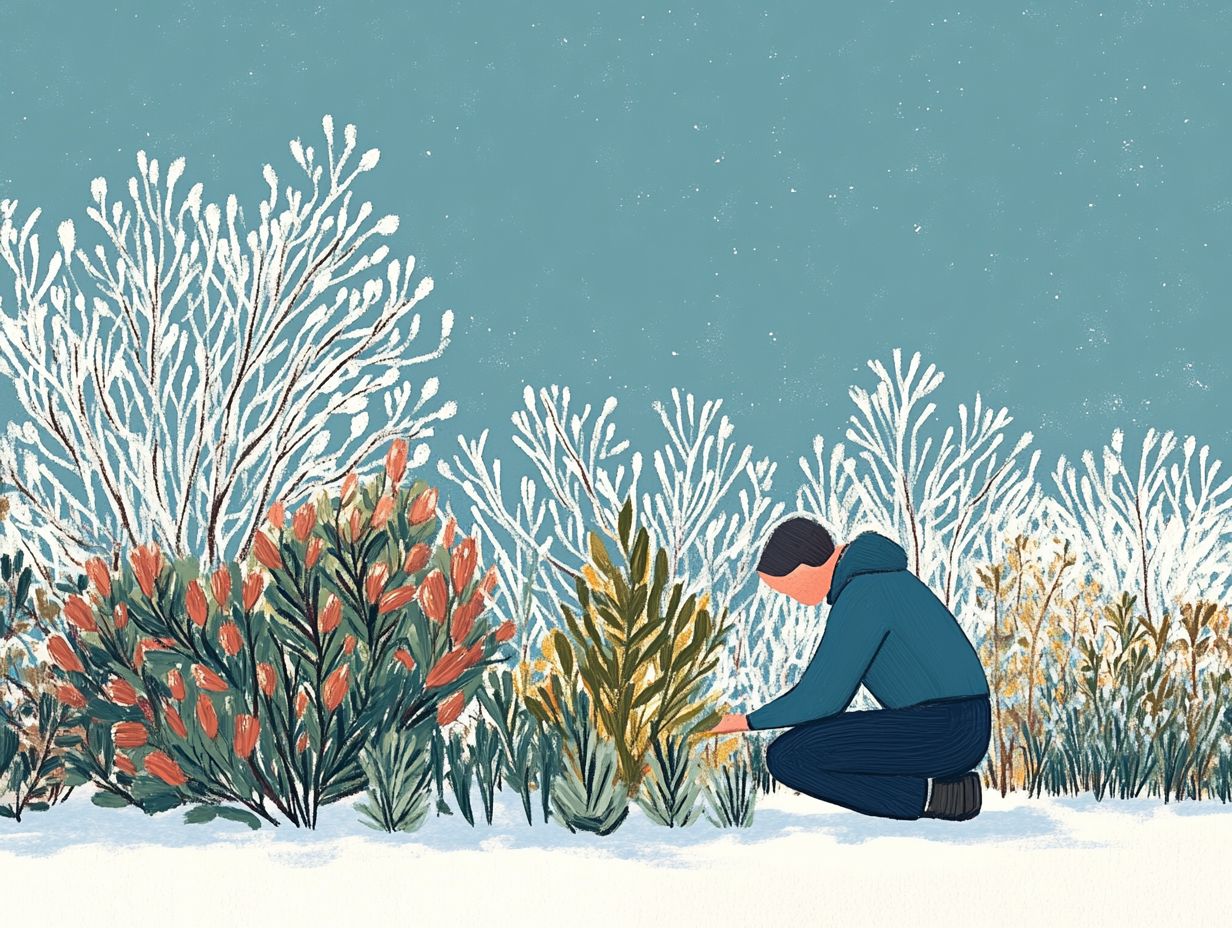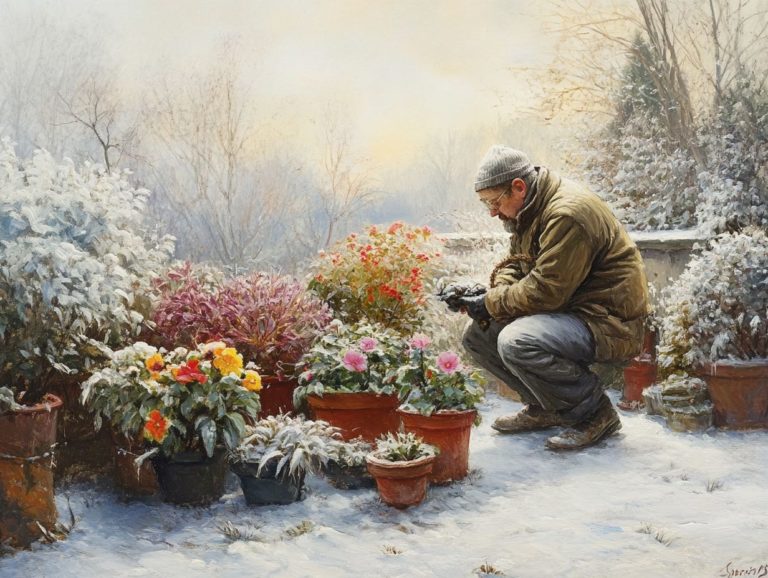Choosing Plants for an Eco-Friendly Cold Garden
Creating an eco-friendly cold garden is more than just a passing trend; it’s an essential stride toward sustainable living.
By carefully selecting the right plants and designing with nature in mind, you can nurture a garden that flourishes in colder climates while benefiting the environment.
This guide delves into the significance of eco-friendly gardening, highlights key factors to consider when choosing plants, and presents effective strategies for designing and maintaining your cold garden.
Imagine your garden buzzing with life as you cultivate native plants! You ll discover how to create a vibrant, eco-conscious space that reflects your commitment to the planet.
Contents
- Key Takeaways:
- The Importance of Eco-Friendly Gardening
- Factors to Consider When Choosing Plants
- Types of Plants for a Cold Garden
- Designing an Eco-Friendly Cold Garden
- Maintaining an Eco-Friendly Cold Garden
- Frequently Asked Questions
- What should I consider when choosing plants for an eco-friendly cold garden?
- What are some examples of hardy plants for a cold garden?
- How can I ensure my plants are water-efficient for an eco-friendly cold garden?
- Which plants are best for attracting beneficial insects and wildlife?
- Can I use organic gardening methods in my cold garden?
- Are there any plants I should avoid in an eco-friendly cold garden?
Key Takeaways:

- Choose cold-hardy and native plants for an eco-friendly cold garden to promote sustainability and reduce maintenance.
- Incorporate natural elements and features, and create a habitat for wildlife to encourage a balanced ecosystem.
- Use organic pest control and proper watering techniques to maintain an eco-friendly cold garden.
The Importance of Eco-Friendly Gardening
Eco-friendly gardening is essential for sustaining the environment while enhancing the beauty and productivity of your garden.
As concerns about biodiversity loss and increasing carbon footprints grow, using eco-friendly practices is not just helpful; it s necessary.
Incorporating native plants and resilient perennials attracts pollinators and helps promote environmental sustainability. Strategies like container gardening and implementing rainwater catchment systems cultivate a flourishing ecosystem that minimizes harm to the planet while maximizing the health of your garden.
Benefits for the Environment and Your Garden
Adopting eco-friendly gardening practices significantly enhances the biodiversity of your garden, creating vital habitats for pollinators and other beneficial wildlife.
By cultivating native plants and minimizing the use of synthetic pesticides, you establish a sustainable ecosystem that attracts bees, butterflies, and birds while improving soil health. This approach enriches the variety of flora and fauna, helping to maintain local ecosystems’ balance.
These practices also help keep the air clean and promote the overall health of pollinator populations, which are vital for the flourishing of fruits and vegetables in your garden.
Factors to Consider When Choosing Plants
When choosing plants for your garden, especially in a cold climate like Montana or Ohio, consider factors such as USDA Hardiness Zones. This system helps you know which plants can survive in your area s climate.
Cold Hardiness and Adaptability
Understanding cold hardiness and adaptability is crucial for anyone gardening in regions like Montana and Ohio, where harsh winters pose challenges to plant survival.
The USDA Hardiness Zones are invaluable tools, guiding you in selecting plants likely to thrive in various climates across the country. By choosing hardy perennials suited for colder zones, you can create a stunning landscape that endures even through the frostiest months.
Take lavender Munstead, for instance this plant offers both aesthetic charm and impressive resilience. Meanwhile, the perennial cornflower bursts forth with vibrant blooms that can brave frigid temperatures.
By selecting plants rated for your specific hardiness zone, you ensure your garden remains beautiful and sustainable year-round, enriching your outdoor space even when winter’s chill takes hold.
Sustainability and Native Species

Incorporating native species into your garden promotes sustainability. It also enhances biodiversity and transforms your garden into a resilient habitat for wildlife.
By choosing plants that are perfectly suited to your local climate, you can significantly cut down on excessive watering and fertilizers. This fosters a better connection with the environment. These plants have evolved to thrive in their ecosystems, supporting pollinators, birds, and beneficial insects. They also diminish the risk of disease and pest issues.
Embracing drought-tolerant species conserves precious water resources. It also nurtures soil health by reducing erosion and enhancing carbon sequestration, the process of capturing and storing carbon dioxide from the atmosphere. Engaging in responsible gardening practices helps you cultivate a vibrant landscape that aligns with ecological balance. This ensures both your garden and the surrounding ecosystem flourish beautifully.
Types of Plants for a Cold Garden
Cultivating a flourishing garden in cold climates starts with choosing the right plants. Additionally, it’s vital to know how to select the right soil for cold gardens. Focus on resilient perennials, hardy biennials that live for two years and bloom in the second year, and cool-season annuals that can thrive through harsh winters.
By selecting these robust varieties, you set the stage for a vibrant garden that can withstand the elements.
Perennials, Annuals, and Biennials
Understanding the distinctions between perennials, annuals, and biennials is crucial for cultivating a cold garden that thrives throughout the seasons. By grasping these categories, you can make informed decisions regarding plant selection and care. This ensures a vibrant landscape even during the chillier months.
Tough perennials, such as coneflowers and sedums, prove to be invaluable allies. They return year after year, enduring harsh temperatures and introducing captivating textures and colors to your garden. Cool-season annuals like pansies and snapdragons bring seasonal blooms to life in early spring and late fall, providing delightful color when many other plants are hibernating.
By understanding these characteristics, you can craft a resilient garden ecosystem that not only survives but flourishes in colder climates, especially with understanding plant selection for cold-climate design.
Edible Plants and Herbs
Incorporating edible plants and herbs like tomatoes, oregano, and lavender Munstead into your cold garden elevates culinary potential. It also enhances its visual charm.
These resilient plants thrive even in lower temperatures, allowing you to relish the joy of fresh ingredients throughout the year, regardless of the chill. Imagine the vibrant green of fresh oregano providing a striking contrast to seasonal blooms, while colorful tomatoes introduce lovely splashes of color against a winter backdrop.
Herbs like rosemary and thyme not only elevate your savory dishes but also release delightful fragrances that can transform your outdoor space into a sensory paradise.
By weaving these functional food sources into your garden design, you create a living tapestry that is both stunning and practical. This promotes sustainability and enriches your meal preparations.
Designing an Eco-Friendly Cold Garden
Designing an eco-friendly cold garden requires you to thoughtfully incorporate natural elements and features. For those interested in enhancing biodiversity, selecting plants for cold climate community gardens can help create a warm and inviting habitat for wildlife.
By embracing these principles, you cultivate a space that nurtures both the environment and its inhabitants.
Incorporating Natural Elements and Features

Incorporating natural elements such as stone pathways, native plant beds, and water features can elevate your landscape. These features create a home for wildlife in your eco-friendly garden.
By strategically placing these elements, you can craft a sanctuary that enhances the aesthetic appeal of your space. It also invites pollinators, birds, and beneficial insects to thrive.
Native plants have impressive deep root systems. They adapt well and require less water and maintenance, conserving precious resources while supporting local biodiversity.
Water elements like ponds or birdbaths serve as vital hydration sources and breeding grounds for various species.
Using organic compost and creating mulched areas can significantly improve soil health. This fosters a flourishing ecosystem. Each of these components works in harmony to create an inviting environment while minimizing your ecological footprint.
Creating a Habitat for Wildlife
Creating a habitat for wildlife is vital for eco-friendly gardening. It invites biodiversity and supports pollinators in your chilly garden, especially when you consider how to plan your cold-climate garden layout.
This approach benefits the environment and enhances the beauty and functionality of your outdoor space. By incorporating native plants, you can attract local species of birds, butterflies, and bees crucial players in pollination and the overall health of your ecosystem.
Focusing on these plants allows your garden to flourish with minimal artificial inputs, aligning perfectly with sustainable practices.
Implementing eco-friendly measures like rainwater harvesting, composting, and minimizing chemical usage greatly aids in crafting your thriving wildlife sanctuary. These strategies cultivate a harmonious relationship between your garden and the wildlife it nurtures, fostering a balanced ecosystem.
Maintaining an Eco-Friendly Cold Garden
To maintain an eco-friendly cold garden, embrace organic pest control methods and adopt proper watering techniques. Additionally, selecting plants for cold-climate rain gardens ensures the health of your plants and fosters biodiversity within your garden ecosystem.
Organic Pest Control and Fertilization
Organic pest control and fertilization are essential for anyone looking to cultivate an eco-friendly garden. By prioritizing these methods, you promote biodiversity while minimizing the use of harmful chemicals that can affect the environment.
When you embrace these strategies, you create a thriving ecosystem that supports plant health. It attracts beneficial insects, like pollinators and predatory species, which naturally manage pest populations.
Techniques like companion planting where specific plants are grouped together to deter unwanted pests or enhance nutrient uptake can significantly bolster the resilience of your garden.
Choosing natural fertilizers like compost and well-rotted manure enriches the soil without the adverse effects associated with synthetic alternatives. This helps foster a healthy, robust environment where your plants can truly flourish.
Proper Watering and Mulching Techniques
Implementing proper watering and mulching techniques is vital for maintaining the health of your eco-friendly garden, especially when incorporating drought-tolerant plants.
These strategies ensure your garden flourishes and play a crucial role in conserving water. They are essential aspects of sustainable gardening practices.
Opt for effective watering methods like drip irrigation or soaker hoses. These methods deliver moisture directly to the roots, reducing evaporation and providing your plants with just the right amount of hydration.
Applying mulch acts as a protective barrier, helping to retain soil moisture while suppressing pesky weeds that compete for resources. By combining efficient watering with mulching, you create an optimal environment that promotes growth while minimizing your environmental impact.
Frequently Asked Questions
Have questions about eco-friendly gardening? Here are some common inquiries answered.

What should I consider when choosing plants for an eco-friendly cold garden?
Choose hardiness, water needs, and the ability to attract beneficial insects. These factors are key for your cold garden!
What are some examples of hardy plants for a cold garden?
Consider conifers, winterberry, hellebores, and winter jasmine. These plants thrive in colder climates, and you can learn more about how to choose the right plants for cold weather.
How can I ensure my plants are water-efficient for an eco-friendly cold garden?
Look for native plants that suit your climate and soil. They need less watering and care!
Which plants are best for attracting beneficial insects and wildlife?
Bright, nectar-rich flowers like echinacea, bee balm, and butterfly weed draw in bees and butterflies. Native plants like elderberry and serviceberry also attract birds and small mammals.
Can I use organic gardening methods in my cold garden?
Absolutely! You can use natural fertilizers, compost, and steer clear of harmful pesticides.
Are there any plants I should avoid in an eco-friendly cold garden?
Stay away from invasive plants. They harm local ecosystems and take over other plants. Examples are English ivy, Japanese knotweed, and purple loosestrife.






